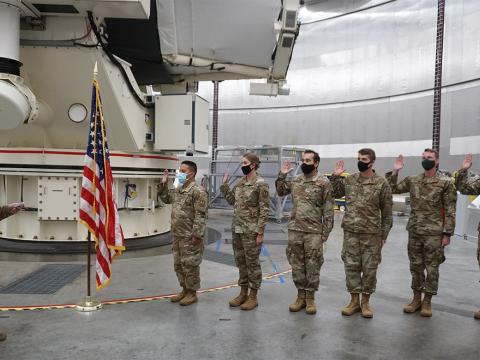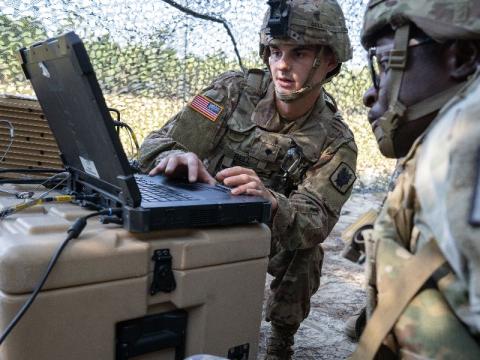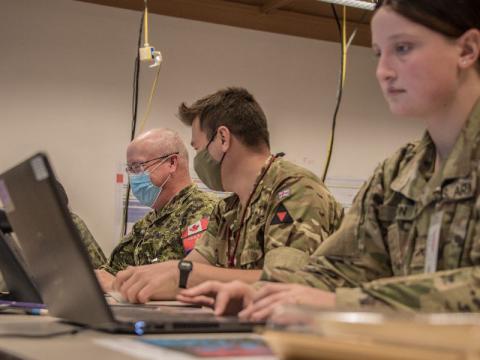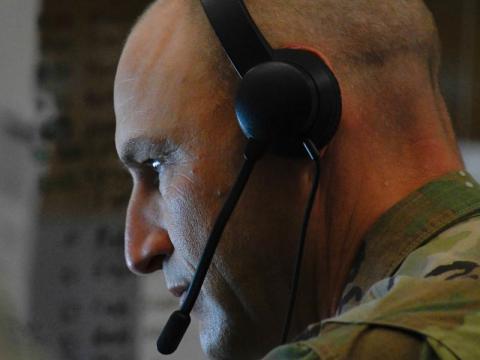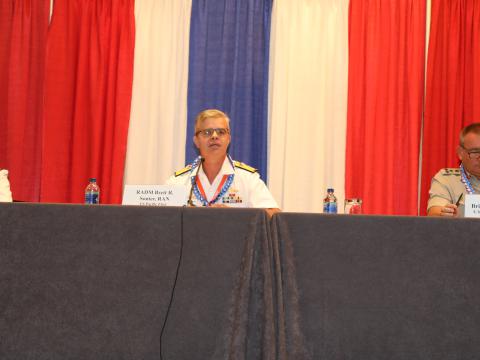Digital Communications Enter New Markets
Programmable, interoperable equipment opens door to ubiquitous battlefield networking. 

The FlexNet family of radios is designed to provide the international tactical communications market with a flexible network-centric capability. FlexNet-One (l) and FlexNet-Four (r) software-defined radios feature a common waveform that can interoperate with legacy systems.
A family of software-based radios designed specifically for export will allow many nations to acquire network-centric capabilities for their ground forces. Built around a waveform engineered to meet international standards, the radios permit legacy equipment to interoperate with other national or coalition systems in ad hoc mobile communications networks.
The radios are the result of a recently announced partnership between the Thales Group,
The FlexNet line currently consists of two radios and a waveform. The FlexNet-Four radio is a multichannel SDR for vehicular use. It is designed to provide increased connectivity between mobile forces, headquarters units and small tactical forces. The radio features four simultaneous channels and an embedded routing capability, allowing the system to act as a communications node. Each channel can be programmed and configured for a different mission, depending on the platform in which it is installed.
FlexNet-Four also provides networking and cross-band functions to connect users to radio networks operating in different frequency ranges. It can transmit voice, data, images and video across battlefield networks. The radio’s programmable hardware platform supports the FlexNet waveform, which allows enhanced functionality and waveform portability. The transceiver operates in very high frequency (VHF) and ultrahigh frequency (UHF) bandwidths in the 2-megahertz to 2-gigahertz range. Data can be transmitted up to 64 kilobits per second in VHF and up to 6 megabits per second in UHF. “It’s a key element in the middle of the battlespace because it will deal with quality of services, different waveforms, interoperability of coalition forces and security issues,” Michaux says.
The FlexNet-One radio is a compact vehicular narrow- and wideband VHF/UHF system. It is a single-channel SDR designed to be easily integrated with any vehicle and is form/fit compatible with the Thales PR4G system. The radio operates in the 30-megahertz to 512-megahertz range. As with the FlexNet-Four radio, the FlexNet-One can transmit data up to 64 kilobits per second in VHF and up to 6 megabits per second in UHF.
Both radios are designed to support standard legacy waveforms such as the PR4G and PR4G F@stnet waveforms. They also can interface with Ethernet systems at data rates ranging from 10 to 100 megabits per second. Optional equipment includes internal or external global positioning system receivers and embedded or external encryption systems.
The heart of the system is the FlexNet waveform that allows high-data-rate transmissions between mobile users and integrates a networking layer enabling up to 150 mobile nodes to connect to a network automatically. Automated network management functions monitor link quality and available bandwidth and enable the optimized relaying of data packets between mobile nodes. The FlexNet waveform also allows networks to merge and split under adverse conditions—such as jamming—without the need for preplanning.
Fully compliant with the software communications architecture (SCA) standard, the waveform provides asynchronous data transmissions for a variety of applications. In addition, it supports multimedia functions such as teleconferencing, video transmissions and voice over Internet protocol. Broadcasts can be varied to provide time-critical data for weapons systems and situational awareness applications while noncritical transmissions such as file transfers, e-mail and database queries can be broadcast sporadically or in sessions.
According to Alan Prowse, Rockwell Collins’ senior director, international software defined radios, many countries are interested in SDR technology. Because the
Non-alliance countries such as
Prowse notes that the FlexNet waveform architecture is SCA 2.2 compliant, which allows customers to develop their own waveforms to meet their specific needs. Because it is too expensive for most nations to replace all of their legacy radios with SDRs, FlexNet systems must be interoperable. One way to achieve this capability is to allow nations to run their legacy waveforms on the new radios and to create their own waveforms. “We’re going to provide a development tool where they [the customers] can actually develop waveforms on the FlexNet-Four. Not only can you make the waveform, but you can also deploy it if you want to,” he says.
FlexNet fills a void between the high-capacity microwave radio systems used at the headquarters level and tactical personal radios the infantry uses. Prowse explains that mobile, vehicle-mounted troops must stay connected with both groups, but they cannot rely on fixed communications networks to maintain connectivity.
 |
| The FlexNet radios were developed to allow armies to form ad hoc communications networks while on the move. Before these systems became available, only a few armies in the world could perform battlefield networking without halting. |
Michaux notes that these node services will be embedded in the FlexNet-Four system to provide a more flexible, software-programmable solution, allowing users to optimize their networks to suit specific types of deployments. “You have to make sure that you’re able to configure your overall communications system for all those different kinds of requirements and that you can reconfigure it dynamically as missions change. This is difficult to do today because current systems do not have this kind of flexibility,” he says.
The market for defense tactical communications represents varying levels of maturity as some nations possess sophisticated networks and others do not, he observes. It is important to help customers move to new systems while maintaining their legacy equipment, he adds. For example, many Thales customers still use Eurocom technologies that are becoming obsolete. The company is working with these nations not only to support their legacy systems but also to move them toward more capable IP-based technologies.
The FlexNet family of products will be very important as a communications node and network transfer system in an increasingly mobile battlefield. Michaux explains that forces must be interconnected to provide situational awareness and to share data. He notes that an adaptable system is vital to link forces on the move by providing ad hoc routing that can operate at longer ranges than current systems.
The partnership with Thales also allows Rockwell Collins access to a variety of new markets. Prowse notes that some 20 nations use Thales’ PR4G radios. This wide distribution means that the FlexNet-One radio will be important to this market because it gives nations much higher data rates across their PR4G networks. “They can literally pull out their existing radios, plug the new one in and get that capability,” he explains.
Prowse believes that the key contribution Rockwell Collins brings to the relationship with Thales is its networking expertise. He is quick to note that Thales also has a very strong networking capability but that the combination of the two firm’s knowledge on the subject creates a synergy of capabilities. Both firms have partnered in developing the Cluster 5 handheld radios for the
Thales and Rockwell Collins formally launched the FlexNet initiative in December, but the radios and the waveform were not introduced until June. The first FlexNet-Four radios will be delivered to
However, the FlexNet-One SDR is a fully joint development by the two firms. Its progress is slightly behind the FlexNet-Four system, Prowse says. The first FlexNet-One units will be available in mid-2007 with full production status expected by mid-2008. “We had the advantage of being under contract for TDRS for some time to get FlexNet-Four into a fairly mature state,” he says. Although unwilling to name other customers specifically, Prowse notes that FlexNet-Four is being selected for several major international programs, and awards will be announced in the fall.
Other nations are watching
He adds that the Swedish example is indicative of the way many nations will use FlexNet—they will field some of the radios, experiment with them to understand how they affect national operational concepts and then decide whether to use the radios to complement their legacy systems or to replace the existing equipment base. “It really does change your CONOPS [concept of operations] perspective from a hierarchical one to a more distributed one where it’s like being on the Internet and you can talk to anyone you want to. Whereas in existing systems you go from section to platoon to brigade and division and then back down to another chain, when you have a mobile ad hoc network you really change the way people communicate,” he says.
Web Resources
Thales Group: www.thalesgroup.com
Rockwell Collins: www.rockwellcollins.com



